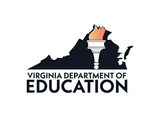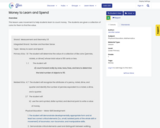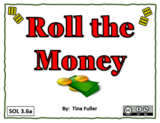
Coins in Pocket Task Template, Student Version of Task, Anchor Pages and Scoring Rationale
- Subject:
- Mathematics
- Material Type:
- Lesson Plan
- Provider:
- VDOE
- Author:
- VDOE
- Date Added:
- 10/04/2024

Coins in Pocket Task Template, Student Version of Task, Anchor Pages and Scoring Rationale

Cool Coin Comparisons Mathematics Instructional Plan

Explore Creating and Counting Collections of Bills and Coins - Rich Mathematical Task Template, Student Version, Anchor Papers, and Scoring Rationale

Counting bills and coins, comparing values, and making change - Mathematics Instructional Plan

Fractions, Decimals, and Percents with Money Algebra Readiness Remediation Plan

This is a cross-curricular activity that uses the story Alexander, Who Used to Be Rich Last Sunday to practice money and decimal skills in addition to reading and writing skills. After reading or hearing the story, students will complete the attached worksheet. (If it's read aloud, students would need a way to refer back to the story to answer the questions. The worksheet has a mixture of reading and math questions. It can be edited if you choose. It can be used for either 3rd or 4th grade. With slight modifications, it could also be used for middle school EL students to learn about currency.

This science and math lesson uses coated candy and water to create a rainbow on a plate. It takes a popular internet activity and modifies it for the classroom. It's extended by having students hypothesize if other temperatures of water will work and if different colors of the candies run faster than others. It also meets the math SOLs because students can calculate the cost of the experiment and/or create graphs of the results of the experiments. You could extend this activity into art or English writing by having students draw their rainbows or write about what they saw happening on the plate as a report writing. You could have them take it a step further and do a creative writing about what they think is at the other end of the rainbow.

2.7 Coin Collection Comparisons Co-Teaching MIP

Unit 7 introduces students to an entirely new category of number—decimals. Students will explore decimals and their relationship to fractions, seeing that tenths and hundredths are particularly important fractional units because they represent an extension of the place value system into a new kind of number called decimals. Thus, students expand their conception of what a “number” is to encompass this entirely new category, which they will rely on for the remainder of their mathematical education.
Students have previously encountered an example of needing to change their understanding of what a number is in Grade 3, when the term came to include fractions. Their Grade 3 understanding of fractions (3.NF.A), as well as their work with fractions so far this year (4.NF.A, 4.NF.B), will provide the foundation upon which decimal numbers, their equivalence to fractions, their comparison, and their addition will be built. Students also developed an understanding of money in Grade 2, working with quantities either less than one dollar or whole dollar amounts (2.MD.8). But with the knowledge acquired in this unit, students will be able to work with money represented as decimals, as it so often is.
Thus, students rely on their work with fractions to see the importance of a tenth as a fractional unit as an extension of the place value system in Topic A, then expand that understanding to hundredths in Topic B. Throughout Topics A and B, students convert between fraction, decimal, unit, and expanded forms to encourage these connections (4.NF.6). Then students learn to compare decimals in Topic C (4.NF.7) and add decimal fractions in Topic D (4.NF.5). Finally, students apply this decimal understanding to solve word problems, including those particularly related to money, at the end of the unit. Thus, the work with money (4.MD.2) supports the major work and main focus of the unit on decimals.
While students will have ample opportunities to engage with the standards for mathematical practice, they’ll rely heavily on looking for and making use of structure (MP.7), particularly the structure of the place value system. They will also construct viable arguments and critique the reasoning of others (MP.3) using various decimal fraction models to support their reasoning.

Just in Time Quick Check Count and Compare Coins

Just in Time Quick Check Write the Value of Money

Just in Time Quick Check Identify Coins

Coin Values Mathematics Instructional Plan

Coins and Socks - Identifying and Describing Pennies, Nickels, Dimes, and Quarters - Mathematics Instructional Plan

3.6 Making Change Co-Teaching MIP

Counting bills and coins, comparing values, and making change. Mathematics Instructional Plans (MIPs) help teachers align instruction with the Mathematics Standards of Learning (SOL) by providing examples of how the knowledge, skills and processes found in the SOL and curriculum framework can be presented to students in the classroom.

This lesson uses movement to help students learn to count money. The students are given a collection of coins for them to find the value.

Counting money is an important life skill. I created this game to give my students hands on practice with counting money. This activity supports sol 3.6a, determine the value of a collection of bills and coins whose total value is $5.00 or less. This game has three recording sheets so that you can differentiate based on the needs of your students. Students play with a partner to roll a die, write the number under each column, and put coins on the work mat to count. Before playing this game, we sorted coins and talked about their characteristics. Students need to be able to recognize the coins and know their value to be able to count money. While students play the game, I walk around to help students as needed and to assess their counting ability. This helps to guide my instruction for future lessons.

Students will practice counting money up to five dollars using grocery ads from local stores.The remix includes suggestions on another way to do the activity and a way to modify so it can be used for 5th grade.